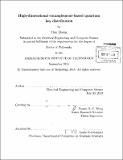High-dimensional entanglement-based quantum key distribution
Author(s)
Zhong, Tian, Ph. D. Massachusetts Institute of Technology
DownloadFull printable version (14.76Mb)
Other Contributors
Massachusetts Institute of Technology. Department of Electrical Engineering and Computer Science.
Advisor
Franco N. C. Wong.
Terms of use
Metadata
Show full item recordAbstract
Conventional quantum key distribution (QKD) uses a discrete two-dimensional Hilbert space for key encoding, such as the polarization state of a single photon. In contrast, high-dimensional QKD allows encoding onto a larger state space, such as multiple levels of a continuous variable of a single photon, thus enabling the system to achieve higher photon information efficiency (bits/photon) and potentially higher key rate (bits/second). However, its deployment requires high-performance source, detector, and routing technologies tailored to the specific large-alphabet encoding scheme. One such high-dimensional QKD system of interest is based on time-energy entanglement, in which keys are derived from the arrival times of photon pairs generated from continuous-wave (CW) spontaneous parametric downconversion (SPDC). This thesis focuses on the implementation of a time-energy entanglement-based QKD system, with the development of several enabling technologies including an efficient single-spatial-mode source of time-energy entangled photons based on a periodically-poled KTiOPO4 (PPKTP) waveguide, GHz self-differencing InGaAs singlephoton avalanche diodes (SPADs), and the first demonstration of non-locally dispersion-canceled Franson quantum interferometry achieving 99.6% visibility. We then utilize these technologies to perform two full QKD protocols. The first protocol uses SPDCgenerated entangled photons for both key extraction and Franson interferometry, yielding a secure key rate -90 kbits/s with up to 4 bits/photon after error-correction and privacy amplification. The second protocol deploys two different photon sources: an amplified spontaneous emission (ASE) source is pulse-position modulated to perform random key generation, and a CW-SPDC source is for Franson security check. In this latter case, we have achieved a secure key rate 7.3 Mbits/s with 2.9 bits/photon, which represents the state-of-the-art in today's QKD technology.
Description
Thesis (Ph. D.)--Massachusetts Institute of Technology, Department of Electrical Engineering and Computer Science, 2013. Cataloged from PDF version of thesis. Includes bibliographical references (pages 135-148).
Date issued
2013Department
Massachusetts Institute of Technology. Department of Electrical Engineering and Computer SciencePublisher
Massachusetts Institute of Technology
Keywords
Electrical Engineering and Computer Science.